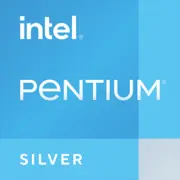Intel Pentium Silver J5040

Intel Pentium Silver J5040: A Budget Processor for Compact Systems
April 2025
1. Key Specifications: Architecture, Manufacturing Process, and Key Features
Codename and Architecture
The Intel Pentium Silver J5040 processor belongs to the Gemini Lake Refresh lineup—an evolutionary update to the Gemini Lake platform introduced in 2019. The architecture is optimized for compact devices with a focus on energy efficiency.
Manufacturing Process and Thermal Design Power (TDP)
Manufactured using a 14nm process, which by 2025 is considered outdated but remains relevant for niche solutions. The processor's TDP is 10W, allowing for passive cooling or a compact heatsink.
Performance
- 4 cores, 4 threads with a base frequency of 2.0 GHz (turbo boost up to 3.2 GHz).
- L3 cache of 4 MB—sufficient for basic tasks, but inadequate for complex multithreaded workloads.
- Integrated graphics: Intel UHD Graphics 605 with a frequency of up to 800 MHz. Supports 4K@60Hz through HDMI 2.0.
- Geekbench 6 results: 435 (single-core), 1180 (multi-core). For comparison, a modern budget Core i3-13100 scores ~1800/5500.
Key Features
- Support for hardware video decoding of VP9 and H.265—ideal for streaming.
- Integration with Wi-Fi 5 and Bluetooth 5.0 (depends on the motherboard).
- Low cost: New systems based on the J5040 start at $150 (mini-PCs).
2. Compatible Motherboards: Sockets, Chipsets, and Selection Nuances
Platform Features
The processor uses a soldered BGA socket, meaning that the J5040 cannot be replaced or upgraded. It is only available as part of ready-made motherboards or mini-PCs.
Chipsets
Based on the integrated Gemini Lake Refresh chip (Intel SoC), which combines memory controllers, PCIe 2.0 (6 lanes), and USB 3.1.
Examples of Motherboards
- ASRock J5040-ITX (Mini-ITX, price ~$90): 2 DDR4 slots, HDMI 2.0, 4x SATA, Gigabit Ethernet.
- ASUS PN41-BB (ready-made mini-PC, ~$220): includes 8 GB RAM, 256 GB SSD, Wi-Fi.
Selection Tips
- Check for the required ports (e.g., HDMI 2.0 for 4K).
- For NAS or media center purposes, SATA ports and LAN are important.
- Avoid boards with passive cooling if you plan to run long workloads.
3. Supported Memory
Types and Specifications
- DDR4-2400 MHz in dual-channel mode.
- Maximum capacity—8 GB per channel (16 GB total).
Recommendations
- Minimum 8 GB for Windows 11/Linux.
- For improved integrated graphics performance, use a dual-channel configuration (2x4 GB instead of 1x8 GB).
- DDR5 and LPDDR4x are not supported.
4. Power Supplies: How to Choose
Power Calculation
Considering a TDP of 10 W and peripherals (SSD, RAM, USB devices), a power supply between 60–100 W is sufficient. However, most ready-made solutions use standard external power supplies (e.g., 65 W).
Model Examples
- FSP Group FSP060-DGBN1 (60 W, ~$25): compact, silent.
- For custom builds, the Seasonic SSP-300SUB (300 W, ~$50) is suitable—with a reserve for future upgrades.
Important! Avoid cheap noname power supplies— they may overload the motherboard.
5. Pros and Cons of the Processor
Pros
- Energy efficiency: suitable for 24/7 operation (e.g., home server).
- Silence: passive cooling in most scenarios.
- Low price: ready-made mini-PCs are cheaper than ultrabooks.
Cons
- Weak performance: struggles with Photoshop, modern browsers with many tabs.
- No support for PCIe 3.0/4.0—discrete graphics cards or NVMe SSDs will not reach their full potential.
- Limited OS support: Windows 11 requires workarounds for installation.
6. Use Cases
Office and Web Browsing
- Working with documents, Zoom conferences, watching YouTube in 1080p.
- Example: Mini-PC Beelink U59 Pro (J5040, 8 GB RAM) handles basic tasks but "thinks" upon opening 20+ tabs in Chrome.
Media Center
- 4K video via Plex/Kodi, streaming Netflix.
- Compatible with HDR but won't handle machine learning for upscale filters.
Light Gaming
- Minecraft (30–40 fps on low settings), Stardew Valley, games up to 2015.
- Cloud gaming (GeForce Now) is an optimal option.
Server Tasks
- NAS based on OpenMediaVault, home VPN server.
7. Comparison with Competitors
AMD Athlon Silver 3050U (Zen, 15 W)
- Pros: SMT (2 threads per core), higher frequency (2.3–3.2 GHz), supports DDR4-2400.
- Cons: TDP 15 W, more expensive (systems from $300).
Raspberry Pi 5 (ARM Cortex-A76)
- Pros: Price (~$80), supports PCIe 2.0.
- Cons: Weaker in x86 applications, limited software ecosystem.
Intel N100 (Alder Lake-N, 6 W)
- Pros: More modern Gracemont cores, DDR5, PCIe 3.0.
- Cons: Systems on N100 start from $250.
8. Assembly Tips
- Case: Choose a compact Mini-ITX case (e.g., InWin Chopin) with ventilation holes.
- Storage: Ensure an SSD (SATA or NVMe, if the motherboard supports).
- OS: Linux (Lubuntu, Ubuntu Server) or Windows 10 LTSC for better optimization.
- Upgrade: Don’t plan for upgrades—the platform is a dead end.
9. Final Conclusion: Who is the J5040 Suitable For?
This processor is a choice for those who are looking for:
- A budget PC for internet, office, or media center use.
- An energy-efficient system for 24/7 operation (e.g., home NAS).
- A compact solution without fans (e.g., a digital photo frame with Smart TV).
Do not consider the J5040 if you need:
- Performance in video editing, gaming, or heavy IDE programming.
- Modern interfaces (USB4, PCIe 4.0).
Alternatives in 2025: Intel N200, AMD Ryzen 3 7320U (for more versatile tasks).
If you value silence, minimalism, and low power consumption—the Pentium Silver J5040 remains a worthy option. However, for future-proof systems, it’s better to look toward Alder Lake-N or Zen 3C.
Basic
CPU Specifications
Memory Specifications
GPU Specifications
Miscellaneous
Benchmarks
Compared to Other CPU
Share in social media
Or Link To Us
<a href="https://cputronic.com/en/cpu/intel-pentium-silver-j5040" target="_blank">Intel Pentium Silver J5040</a>